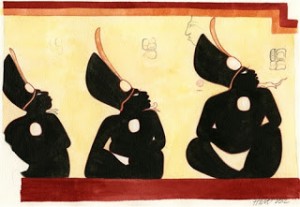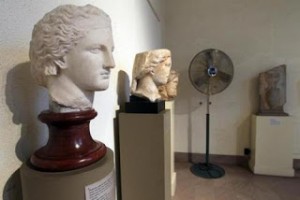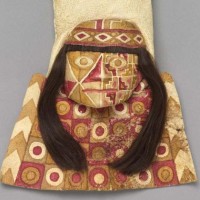Thinking more about yesterday’s Wari pouch post, I asked on of my fearless leaders essentially the question I asked here: why is there a fight now over the Cleveland Museum’s acquisition of a Roman head and a Maya pot when they bought a Wari pouch from Sotheby’s last year that seems to have just as transparent a provenance, at least as published. He said that he felt that Paul Barford’s recent blog post had a very good point, that the ruckus was about the Roman head and that the Maya pot was along for the ride.
I admit, I missed that part of Mr Barford’s post (I usually read the blogs through bleary morningeyes, my glasses misted up from a cup of coffee). He writes:
Is the origin of the Mayan pot somehow less important than the Phrygian marble, that we are all (myself included) hammering on about one and not the other?
This is where my own skewed perceptions come in…and also shows how lightly I was following things. I didn’t know everyone was focusing on the head. I think the head is kind of boring and ‘samey’… The Maya pot, however, is spectacular, unique and filled with the amazing Maya-ness that convinced me to abandon a childish interest in ancient Egypt and and head off to a tent in the deep jungle. It is Maya pottery that tests my limits; it exposes my hypocrisy. I argue here and there against publishing unprovenienced material, yet I consume Justin Kerr’s
maya pot database like a true junky. I think everyone out there has a ‘If I got a tattoo it would be…”, well mine is on an unprovenienced Maya pot. Does that count as publication? I can honestly stare at a particularly detailed codex style pot, perhaps, for a long time. I try to project the scenes on to the jungle sites that I’ve spent time in. I try to make it come alive.
 |
Reconstruction drawing of Xultun mural
by Dr Heather Hurst; LOVE IT! |
I am a lady who spent much of yesterday just looking at and thinking about the
Xultun murals. I emailed Dr. Heather Hurst to see if she sells prints of
her paintings of them…I am probably Hurst’s biggest fan and she doesn’t even know it. Her reconstruction paintings of
the San Bartolo murals make my heart flutter…
I could gush about the different face paint patterns on the figures, the body modification (does that one dude have a pierced head?!); the hair styles. I could drift off in to trying to understand the complicated Maya idea of captive taking and ‘war’. Apparently the pot is tied to the site of
Nibaj; there isn’t an emblem glyph that I can see but there appears to have been some sort of analysis done on a pot in the British Museum which portrays another stage in this sequence of events. I don’t know anything about Nibaj! I feel my distraction for the weekend coming on.
 |
The MFA’s Classical Gallery from the Boston Globe;
This place is a snooze and a half. |
The Roman head, however, seems like kind of a yawn to me. Confession time: I get really quite bored in big, traditional museums. I have fallen asleep inside a gallery of the Fitzwilliam…on two occasions (this from a lady who is unable to nap). At the MFA I head straight to their collection of Copley portraits (in context in Boston!! I *love* 17th and 18th century portraits); I only dip into the Classical Galleries if there is a particular row going on about a piece. I don’t read the signage in those museums, I rarely linger, and I tend to wonder if there is something else I could be doing with my time.
That isn’t to say that I don’t like museums*, but I think that style of museum is tired and has outlived its usefulness. Yawn. Sleepy time. Heads like that one, at least when they end up in a traditional museum, represent all that is boring with the museum experience to me. They will stick it on a pillar, out of context, and I or someone like me will walk by it and not care. Using the MFA as an obvious example, their Roman, Greek and Egyptian galleries have the feel of a tired Junior High School that was built in the 1970s and never updated…the the same washed out colour scheme and sense of resigned despair. To me, all the Roman heads blur together. Yes, this is ironic since I love portrait painting so much, but consider it a fault of traditional museum display rather than the portrait heads themselves. I just can’t stay awake. Just ask
my long-suffering, non archaeologist partner: I am always way ahead of him in this type of museum saying ‘come ON! HURRY UP!’.
But, as it turns out, that is just me! The news story is about the head and not the vase! And that is pretty much what Neil said: the pouch isn’t any different, it just isn’t Greece/Rome/Egypt. Well heck!
* What kind of museums do I like? Well the first that springs to mind is the Museo de la Cultura Maya in Chetumal. I haven’t been there since 2003 so maybe it is terrible now, but I went, what, twice? Three times? While I was living in Belize. That is a lot since I didn’t have a vehicle and Chetumal is in another country. I don’t even know if that museum had any artefacts in it. Probably yes, but they were local and legal of course and they took a back seat. I felt that the museum really portrayed how I felt about the the ancient Maya. The feeling that brought me to Central America, to that horrible tent in the jungle, was there.
The whole place was organised around a version of the Maya world tree, a swirling red ceiba in the style of the one on Pakal’s sarcophagus lid. It connected all floors of the museum: the roots being in a strangle little Xibulba filled with tiny gods of the underworld lurking among the roots; the middle where you experienced the Maya on earth such models of Maya cities that you walked over on glass; the branches where you learned about Maya writing, the calendar and religion. There was a reconstruction of a round Maya house for kids to pop into outside…and the place was air conditioned! Yes!


